Pack rafting the Gordon Gorge
I’ve been pretty desperate to find new rivers to be able to run trips over summer. To that end I decided to head down the Gordon Gorge section of river with pack rafts in order to scout it out before taking proper whitewater rafts down. I put the word out that I was going to do a trip. I got some interest and a couple of other guys (Tom and Darren) were keen to run it. After a last minute bit of organising the three of us set off to the Gorge!
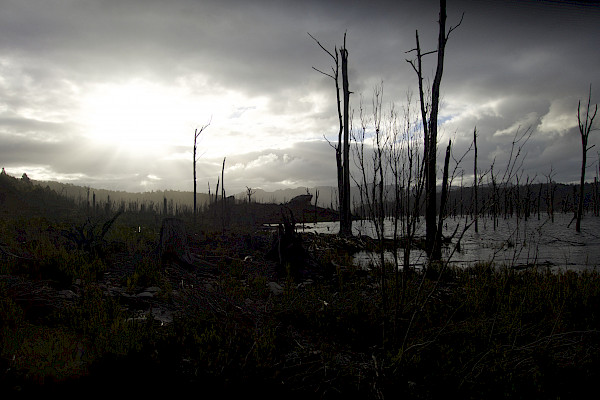
It’s a long drive to get cars in to position and reach the get-in point; the roads are terrible and navigation is tricky. That said, we arrived at around midnight and set up camp ready for a 0600 start. Despite the lack of sleep and generally cold, miserable conditions everyone was in a good mood, which was excellent.
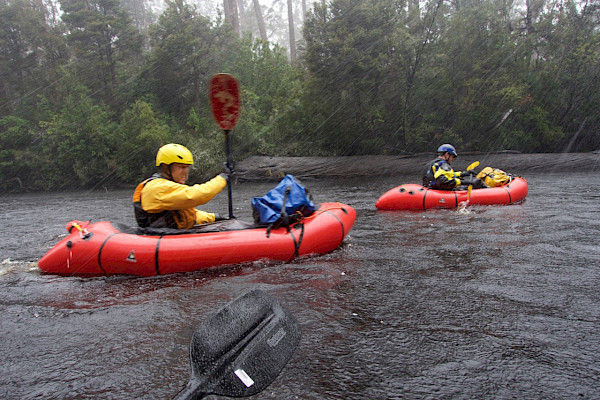
We got on river at about 0700 after a half hour walk to the get in. Ironically the walking track was better in parts than the road we used to get there… Once we got on the Gordon River the weather really started to close in. There had been an extreme weather warning issued for bushwalkers in the region with heavy rain, wind, freezing temperatures and snow down to 500 metres. It was at this point that we started speculating about the river levels. Given none of us had done the river before (and there is no water gauge) we where going in blind. At high water levels the Gordon is a class five whitewater monster so we had some concerns (and the only reason I was running it was that I’d been told it would be class three at low water levels). That said, we had to stop and haul our rafts over logs, and the river was pretty scratchy in places, which put our minds at ease, although we would later find out that it definitely should not have.
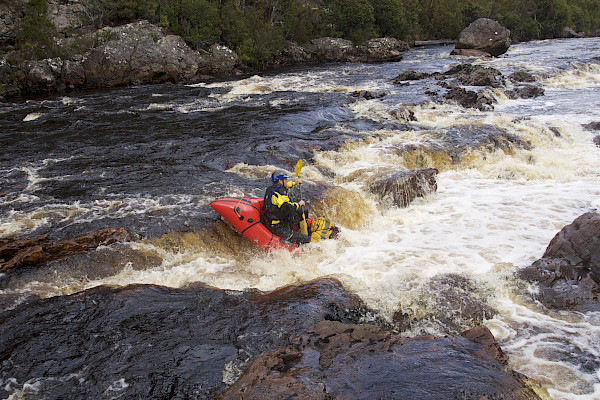
The river started to gradually narrow and become more steep as we finally came across our first rapids. Fairly straightforward class two whitewater was made more difficult by the wind which really pushed the pack rafts around. In the rapid above I almost flipped simply because of a headwind that took all my momentum away just as I was about to go over the drop, so I ended up taking it sideways and just crashing down rather than boofing properly (Tom did the same as you can see in the photo above).
Soon enough we made it to the first serious multi-stage drops with some big stoppers at the bottom of them. I passed the camera over to Tom so he could take some photos of the carnage. Both myself and Darren wiped out however. After watching us fail Tom took the line on river right which saw him through just fine. That’s the value of watching others first! So that you may also learn from my mistakes I have provided below a step by step series of photos on how not to tackle a rapid such as this one.
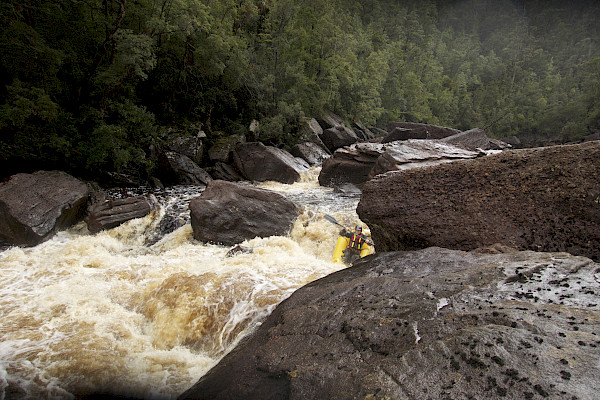
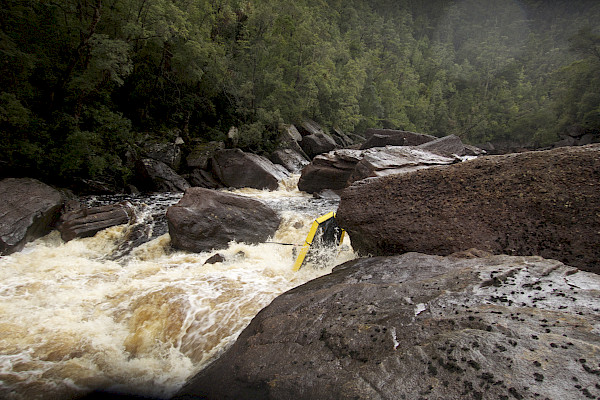
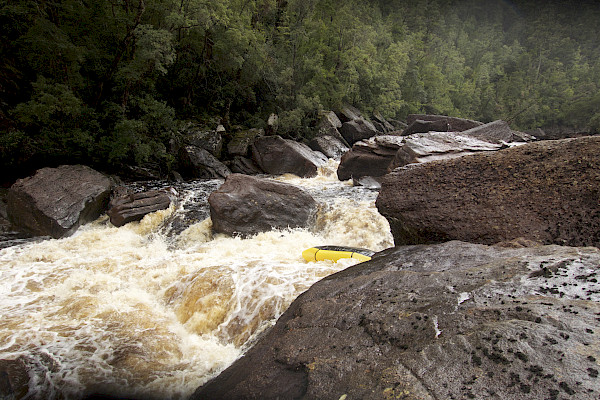
It was a little after this rapid that it became clear that I had underestimated the difficulty of the river. An abandoned kayak at the edge of the river was an ominous sign as was the periodic sound of the rescue helicopter overhead. Magnificent cliffs rose up on either side of the river making a walk out totally impossible and portaging difficult to impossible in places too. It was stunning scenery, definitely the most remarkable river I have been on from that perspective but the river itself was scary. The rain had risen the water level significantly to the point that the rapids where continues. Falling out meant swimming through plenty of nasty features before getting back into the raft was an option.
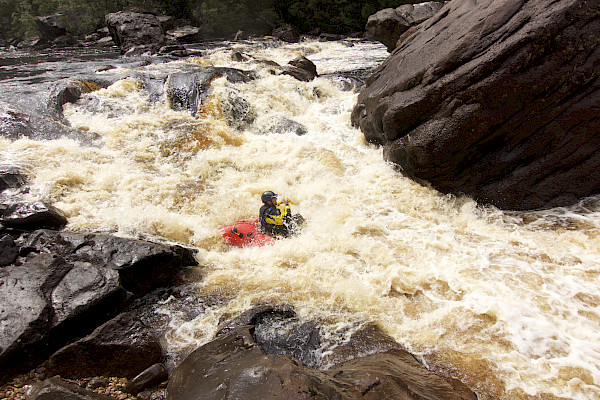
One of the most dangerous features on rivers are sieves. These are points where the river is forced through obstacles like logs and rocks (as water would if you poured it through a sieve in your kitchen). The danger with these is that if you get sucked under them you could become trapped under the debris and drowned. One such feature covered two thirds of the river at one point. It was essentially a massive rock (about the size of a house) which had the river flushing underneath it. Darren misjudged the rapid and ended up heading right for it. By some miracle he managed to hold on to a branch that was jammed in there and haul himself out and on to a small ledge rather than being sucked under. His paddle was not so lucky, it disappeared underneath never to be seen again. Due to his position on the water, slippery rocks and our collective exhaustion it took us a good 20 minutes to get him back to the side using our throw bags.
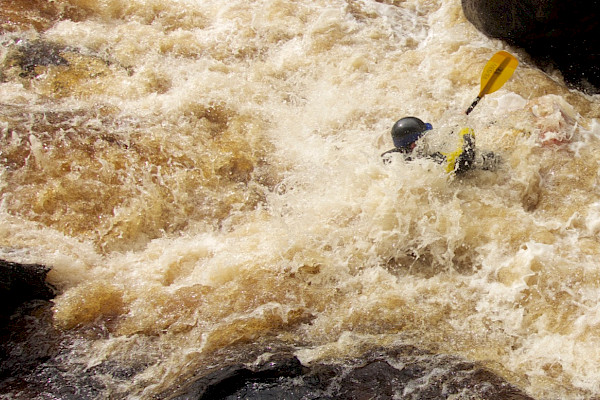
The next few hours where spend doing tricky portages before psyching up for some rapids we had to run because there was no way to walk them. We’d inevitably end up swimming, manage to get to an eddy and get out for some more scrambling over rocks. I ended up getting sucked under a boulder sieve on one such section. I hadn’t seen it until it was too late. Darren attempted to warn me but the force of the water going underneath the rocks didn’t give me an opportunity to do much. I was flipped out of the raft and I managed nothing more that getting myself going feet first before being sucked under…
Swimming in whitewater is something that you get used too after a while. It’s mostly quite noisy and foamy and you get thrown around quite a bit. I’d never been sucked underneath rocks before and it’s a very different and quite bizarre experience.
At first it was the classic foamy water combined with the roaring sound and the panicked yelling of the other guys. That all vanished in an instant to be replaced with pitch black silence as the water flowed under the mess of boulders. It was a surprisingly relaxed experience, I remember just waiting, wondering if I was about to be trapped, crushed between the rocks and drowned. It’s an interesting position to be in because there is really nothing you can do to help yourself, and no opportunity for rescue. Survival is solely based on chance. In my case after a few more seconds of darkness light returned as I was flushed out the other side. Lying on my back still heading downriver I looked over at Tom – he looked like he’d seen a ghost. I have no doubt I would have had the same expression. Darren paddled around grinning and said that it was great that now two of us had almost died, I put up a weak effort to mimic his enthusiasm as I caught my breath at the edge of the river. It’s funny how valuable enthusiasm and positivity can be in miserable situations.
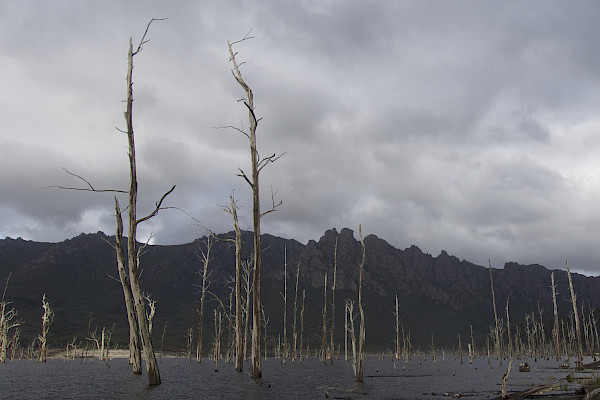
After this I began to crash. I was completely exhausted and had taken enough nasty swims to be keen to avoid pushing fate any further. Lots of high stakes portages where you are scrambling over slippery rocks combined with the adrenaline and exertion of paddling had really taken its toll on me. Darren was pushing on without a paddle which was just incredible and Tom was still running rapids. It was lucky that the team was so competent overall.
Finally we made it back to the flat water of Lake Gordon. Darren walked out while Tom and I paddled to the car. Paddling through the endless dead trees of Lake Gordon is a pretty eerie experience and after the endless roar of the whitewater the total silence really added to the atmosphere. After another long drive with some pretty psychedelic music pumping to keep us awake we were finally home, all utterly spent.